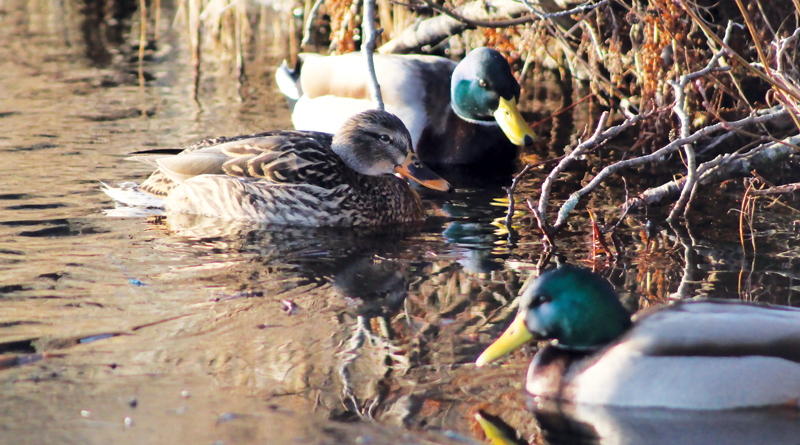DUCK HUNTING WITH BINOCS – Life In The Outdoors

I’ve been duck hunting recently, with a pair of binoculars. I’ve driven to a pond or lake with a road along the shore, then driven slowly along the shore, stopping often, scanning the shore, the water beyond, and the sky above the water.
Mallards are possibly the most common ducks. A male mallard, called a drake, is also one of the most well-known ducks. It has a green head, reddish-brown breast, gray speckled back, and belly, and a tail of black and white. There’s a patch of bright blue, called a speculum, on the trailing edge of the inner part of each wing.
A drake shoveler is another duck with a green head, white around the neck and on the sides and a rusty-red belly. Its wings and tail are much like a mallards. A female is speckled brown, much like a female mallard. The most distinguishing feature of a shoveler is the size of the bill. It’s enormous, much too big, it seems, for a mallard sized bird.
There are many species of ducks and they vary greatly in size. Ruddy ducks and buffleheads are smaller than crows. Red-breasted mergansers are nearly as long as Canada geese though not as heavy. All ducks have relatively short necks and legs and webbed feet.
The most colorful duck, and one of the most colorful birds is a male wood duck. He has a green head, like a drake mallard, with a white stripe from the base of the bill along the side of the head to the back of the neck and another white stripe from the first up to behind each eye. He has a reddish-brown throat with a white stripe at the back on each side, bluish and reddish on the back, a grayish belly, and a patch of reddish-purple in front of the tail on each side and a black tail.
Ducks are lumped, for convenience, into two categories, puddle ducks, also called dabblers, and divers. The mallard is a puddle duck. So is the shoveler and the wood duck, and the gadwall, blue and green-winged teal, pintail and many more. These ducks feed in shallow water, so shallow that they can stick their heads in the water, point their tails at the sky, reach the bottom and feed on what they find there without leaving the water’s surface. When they take flight they appear to jump into the air.
Diving ducks or divers plunge beneath the surface of the water and swim, often to a considerable depth. Diving ducks have been caught in fishing nets more than a hundred feet below the surface. When divers take flight they raise up on the water and run on the surface, as if taxying for take-off, before becoming air born.
Ducks nest on land, all but the wood duck and hooded merganser. Their nests are mats of grass and other vegetation. Soon after their eggs hatch the female leads the ducklings to water. The two exceptions, wood duck and hooded merganser which nest in holes in trees. Since they don’t have bills suitable for chiseling holes in wood like woodpeckers, they are dependent on natural cavities and on holes made by woodpeckers. Soon after hatching, just like ducklings from nests on the ground, the young leave the nest, flutter to the ground, gather around the female, then are led by females to the nearest water.
So how has my duck hunting been going? I’ve seen a number of mallards and even more wood ducks. One wood duck nested in a bird house we have in a tree in our yard, not far from our back door. I had that box put up hoping to attract screech owls which had left droppings on the concrete entrance to our garage nearby. Screech owls never used the box but last year and this year a wood duck has hatched a brood there and I saw them leave.
- Birds As Weather Forecasters – Life In The Outdoors - December 17, 2021
- Rare Bird Spotted In Indiana – Life In The Outdoors - October 8, 2021
- MY EXPERIENCE WITH DEER – Life In The Outdoors - July 30, 2021


